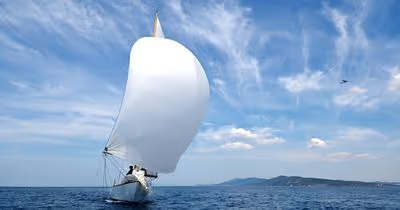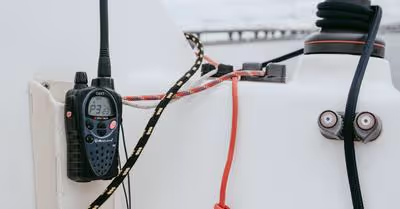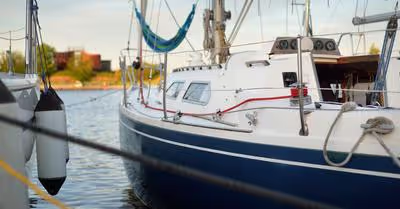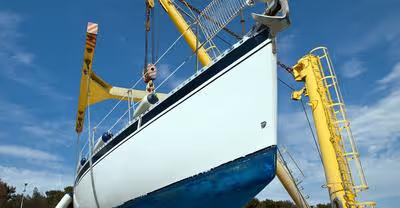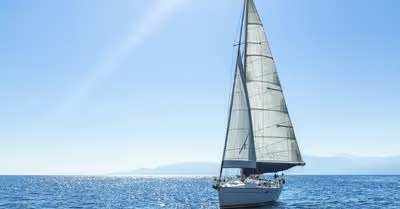Table of Contents
Sailboat Rig Types
Sailboats come in many different shapes and sizes, the rig is what determines how the sails are positioned on that mast or those masts. One type of sailboat rig is a sloop, which has only one mast with two sails attached to it. Another type of sailboat rig is a schooner, which has two or more masts with at least two sails each. A catamaran also has multiple masts, but it splits its mainmast into separate fore-and-aft rigged spars rather than using traditional square rigging like other rigs do. And finally, there’s the yawl which differs from most rigs because it uses the mainmast as the aft-most mast, with a small mizzenmast further aft.
Sloops are used for many purposes including racing and cruising on single-hulled sailboats. This rig may also be referred to as the Marconi rigged sloop because it was invented by Englishman Bithiah Marconi in 1908, who later went on to create an easier-to-sail rig called the Bermuda rig. It gets its name from "slup", which means "ship" in old Dutch.
Sloop rigs are generally considered to be easy to use and control due to the fact that there are only two sails, so most of the focus can remain on controlling the boat itself. However, this also means that sloops may sacrifice speed when compared with other types of sailboat rigs such as the Schooner.
Schooners have two or more masts with at least two sails each. The advantage of schooner rigs over other sailboat rigs is that they’re easier to handle than most traditional rigs which require a lot more attention and effort from the captain and crew members. Schooners often carry a large amount of cargo because their setup allows them to use larger "headsails", which are sails that lay perpendicular to the wind and harness its power.
Schooners can be difficult to tack, meaning they must sail into the wind in order to get moving and move forward. However, because of their total sail area and large cargo capacity, Schooners were one of the most popular types of sailboats during the age of sail (the 1800s).
Yawls also have two or more masts with at least two sails each like schooners do. The difference is that yawl rigs use the mainmast as the aft-most mast, with a small mizzenmast further aft (towards the stern of the boat). This setup is often chosen for sailing boats because it offers a lot of stability and easy handling.
The mizzenmast on a yawl rig is also generally used to carry a smaller mainsail. This extra sail gives yawls an extra edge in speed when sailing downwind, making them some of the fastest sailboats around.
Sloop Sailboat Rig
A sloop is a sailboat with one mast and two sails. The most common rig for a sloop consists of a single mainsail, a large jib attached to the mainmast by a headstay, and a small foresail also attached to the mainmast but by a backstay.
The advantage of a sloop rig is that it allows for efficient sail combinations without changing booms and sheets around. The disadvantage is that the sails do not work as well when sailing across the wind as other rigs (such as a cutter or ketch) do.
The sloop rig has been used for centuries, and is still the most common sailboat rig in use today. It is easy to learn how to sail a sloop, and they are versatile boats that can be sailed in a wide variety of conditions. Sloops are popular for both recreational and racing sailing.
Sloop sailboats can be found in all sizes, from small day sailors to large ocean cruisers. They are easy to trailer and launch, making them a popular choice for sailing on smaller bodies of water. Sloops are also common in yacht racing, where their simplicity and speed often give them an advantage over other, more complicated rigs.
The Sloop sailboat rig is the simplest and most common type of rig. And the Sloop is great for sailing in light to moderate winds. Some of the fastest yachts in history use a sloop rig as its ability to sail well across all points of sail is renowned.
Cutter Sailboat Rig
The cutter rig is similar to a sloop in that it is rigged with both a mainsail and jib. But the cutter has an additional jib sail and was traditionally rigged with a gaff mainsail sail. This type of rig is less common today, but can be found on boats up to about 60 feet in length.
The cutter rig offers a few advantages over the sloop rig. First, the additional jib sail provides more power and stability in high winds. Second, if Gaff equipped - the gaff mainsail sail can provide more power and speed than a comparably sized standard sloop or bermuda mainsail. Third, the cutter rig is more maneuverable than a sloop because either of the jib sails may be moved from side to side independently of the main sail.
In strong winds, a cutter's gaff mainsail provides added stability and power since it can maintain a straighter angle to the wind than a standard sloop. This makes the cutter rig a good choice for sailing in rough seas. The cutter's additional jib sail may also help keep the boat from heeling over too far in strong winds, making it more stable and easier to control.
The cutter rig is also more maneuverable than a sloop. With an additional jib that may be trimmed independently of other sails, the cutter provides more power and control in strong winds, but it also requires more attention while sailing.
A cutter's jib can make it easier to sail in close quarters like harbors because it provides some lateral support against the mainsail, which forms a sort of "wall" behind the boat. The main sail also provides more power and stability in strong winds, which is why the rig has been around since boats were first built. In low winds, a cutter will have less forward propulsion than a sloop or ketch because of its decreased number of sails.
The two disadvantages of a cutter rig is that it requires more attention to control and is less efficient when sailing downwind. The cutter's gaff mainsail is usually more difficult to handle than a standard sloop or staysail, which means that it takes longer to change sails in different wind conditions.
A traditional gaff sail Cutter will have additional challenges. The added complexity of the gaff mainsail also makes this rig slightly less efficient. This is because the gaff mainsail is less streamlined than a standard sloop or staysail. And because the jib sail is smaller than the main sail, it provides less power and speed when sailing downwind. As a result, a cutter will usually require more wind to achieve the same level of speed as a sloop or ketch.
This means that the boat is less efficient in lighter wind conditions.
Cutter rigs are typically found on boats up to about 60 feet in length. Some people may consider this type of rig to be outdated, but they are still common today, particularly on classic or large boats.
The cutter's ability to sail closer into the wind makes it a great choice for sailing in coastal areas with strong winds. Depending on the experience of the Skipper, the gaff mainsail is another benefit that comes into play when sailing in rough waters, and the additional jib sail offers even more stability and control.
However, there are also disadvantages that come with the cutter rig. First, it requires more attention to control and may be less efficient when sailing downwind.
Despite these disadvantages, the cutter rig is still a popular choice for many sailors because it provides more stability and power in strong winds. And its ability to sail closer into the wind makes it a great choice for sailing in coastal areas.
Catboat Sailboat Rig
A catboat is a sailboat with a single mast placed well forward in the bow. This boat typically has a single sail and they’ve most commonly been gaff rigged. Catboats are typically found in the United States, the Bahamas and in Europe.
The catboat first emerged in the early 1800s as a small fishing boat designed to work close to shore. The single mast was placed well forward in the bow so that it could easily be worked by someone on board. The gaff rig was also chosen because it was easy to manage and provided good performance in light winds.
Catboats soon began to be used for recreational sailing, and they quickly became popular in the United States, the Bahamas and Europe. They are now considered a classic design that is both fun and functional.
If you are looking for a unique sailboat with great performance, then it is highly recommended that you consider a catboat. Although they are not as popular as other types of sailboats, you will find that this classic boat provides many benefits.
When compared with other single masted boats, the true catboat offers more room on the deck and is easier to handle. This makes them an excellent choice for those who are new to sailing or those who want a boat that is simple and easy to use.
Catboats also provide good performance in light winds, making them a perfect choice for those who sail in areas where the wind can be variable. And because they are smaller in size, they can be easily transported and stored when not in use.
If you are looking for a great sailboat that is both fun and functional, then the catboat should definitely be at the top of your list. With its unique design and great performance, this boat is sure to provide many hours of enjoyment on the water.
Schooner Sailboat Rig
The Schooner Sailboat Rig is an old and traditional sailing rig. It has two or more masts, all of which may carry square-rigged or gaff-rigged sails, and it's a type of vessel that is still used today. The Schooner Sailboat Rig is a beautiful sight to behold on any day of the year, from calm summers to snowy winters. This rig will allow you to sail with speed and maneuverability as it allows for remarkable control for those who know how to handle it! If you want a boat that can keep up with modern technology, this isn't it. But if you love tradition and beauty in your sailing experience, this may be the perfect choice for you!
When most people think of a sailboat, they envision a sleek and modern vessel with all the latest in technology. But there is another type of sailboat that has been around for centuries and is still sailed today - the Schooner Sailboat Rig. This rig consists of two or more masts, all of which carry square-rigged sails. Schooners are a type of vessel that can be used for many different purposes, such as cruising, racing, or fishing.
One of the great things about Schooners is their maneuverability. They can sail with speed and control, making them a great choice for those who know how to handle them. Schooners are also beautiful vessels to behold, from calm summers to snowy winters. If you're looking for a sailboat that can keep up with modern technology, this may not be the right choice for you. But if you love tradition and beauty in your sailing experience, the Schooner Sailboat Rig may be perfect for you! Note: There are many different types of Schooners - be sure to do your research before purchasing one!
Yawl Sailboat Rig
The Yawl is a traditional two-masted, fore-and-aft rigged sailboat. The main mast is in the center of the boat and carries both mainsails and staysails. Aft of the main mast there's a smaller mizzen mast which usually has one sail. This design offers more speed and maneuverability while sailing upwind than a sloop rig, but can be less stable downwind when running under full sail.
The hull shape of yawls was originally developed as an improvement on older designs like the brigantine and gaff cutter by providing greater stability for vessels used to carry heavy cargo such as timber, stone ballast or wool. The yawl was one of the most popular rigs for medium-sized vessels from the 17th century up to around 1950.
The yawl is also defined as a two masted vessel, with the additional mast smaller than the mainmast and located near the stern.
Although far less common than other rigging layouts such as sloops, ketches and schooners, there are some famous examples in history where yawls have been used for ocean cruises or longer journeys.
A well-known yawl is the classic 12-meter yacht America, which was designed by Olin Stephens and first sailed in 1930. She's now owned by The Royal Yacht Squadron and is still raced regularly in Cowes Week.
Despite their traditional design, yawls are often sailed with modern materials and equipment, making them a popular choice for those looking for a fast and comfortable boat that can also handle offshore sailing conditions. So if you're interested in learning more about this traditional rig, or even thinking of buying a yawl to take on your next trip, contact your local yacht sales and charter experts today.
Ketch Sailboat Rig
The Ketch Rig is a modern sailboat rig. It is the most popular rig used by international racers because it allows for narrower boats, which are faster than wider boats, although a little less stable. It also has the ability to be sailed closer to the wind than other rigs.
The Ketch Rig derives its name from an old Dutch word meaning "to catch." A ketch rig consists of two masts-a mainmast and a smaller mast called the jiggermast or mizzen mast aft of (and usually shorter than) the mainmast. The advantage of this configuration is that it permits working sails much nearer to the centerline, which increases stability as well as reducing heeling error due to unbalanced helm force.
The sail plan usually consists of a mainsail, jib, and one or two spinnakers. The triangular mainsail is set on the mainmast, and a smaller jib is set on the jiggermast. Because the jiggermast is shorter than the mainmast, the jib is closer to the center of effort, which makes for a more stable boat. The ketch rig is also well suited for sailing close to the wind, making it a popular choice for racers.
While the ketch rig was once the most popular sailboat rig, it has been surpassed in popularity by the sloop rig in North America. The early development of the ketch rig's popularity can be attributed to its use in lateen and sprit rigs and for fore and aft sails on wide, useful boats such as yawls and schooners.
Though lugsails are no longer common on recreational boats in North America, they are often seen on traditional vessels such as Cape Dories, Beetle Cats, and Catboat replicas. A lug sail is a four-sided sail that is bent onto a single mast and is usually gaffed (the lower aft corner has a spar or boom attached to it which is lifted high enough to form an extension for the upper aft corner of the sail). A lug jib would also be standard on a ketch rig.
The mizzen of a sailing yacht is sometimes referred to as a "kite". However, this term should not be confused with the parachute-like device of that name used by glider pilots.
The ketch rig is a versatile and popular sailboat rig that is well suited for both racing and cruising. With its two masts, it allows for a narrower boat than other rigs, making it faster and more stable in the wind. It is also well suited for sailing close to the wind, making it a popular choice for racers. Though it has been surpassed in popularity by the sloop rig in North America, the ketch rig is still a popular choice for sailboats.
Sail Types
A study on sailboat rig types would be incomplete without a mention of the types of sails in use.
There are many types of sails, and each has a unique purpose and place in history. Understanding the different types of sails can help you select the right one for your needs, or how to determine the age of an older ship!
Here is a breakdown of the most common types of sails:
Square sail
A square sail is a traditional sail used mostly in antiquity.
The square sail is less common today.
The square sail is an upright rectangle, held open by a horizontal spar or frame called a yard. The earliest wind-powered vessels were constructed by attaching fabric sails to wooden frames in imitation of animal skins fastened to limbs for power, but with sails being manipulated by rope pulls from the deck as in modern times.
Square sails were used as early as Ancient Egypt to help with oar powered boats in windy conditions.
The name "square rig" is said to derive from the use of a square sail, which may be deployed by releasing or removing a halyard .
It was one of the most important ship types in Europe until the end of the wind-powered vessels era. The mainsail was gradually replaced by smaller fore-and-aft sails and eventually became obsolete. The square sail is still used by wind surfers and some racing yachts.
Lateen sail
A lateen sail is triangular and is used on small boats in the Mediterranean. It is designed to catch the wind from the side when tacking into it. This type of sail was also popular in China, India, and Arabia between 700-1500 AD.
The lateen sail has largely been replaced by bermuda sails. However, it still has a place on some boats. The lateen sail is triangular in shape and its origin is unknown. It is thought to have originated in the Mediterranean region.
The lateen sail was used by the Phoenicians and the Carthaginians. They were some of the first people to use this type of sail. The triangular shape is thought to have been inspired by the stitching on animal skins. The Africans, Arabs and Turks used the lateen sail on their ships long before Europeans ever caught on to its use.
The lateen was very easy to build and could be easily adjusted for better controlling of the boat in high winds. It also wasn't likely to rip in high winds like other sails of the time. This made it a popular choice for sailing in the Mediterranean region.
The lateen sail was eventually replaced by the bermuda sail. The bermuda sail is better suited for sailing in the open ocean. However, the lateen sail is still used by some ships.
Bermuda sail
A Bermuda sail is triangular and has long, narrow panels that allow it to catch the wind from all directions. This type of sail is most often used on modern boats.
The bermuda sail is the most popular and ubiquitous sail in history. It originated in the Bermuda region, and its design has been used for centuries by sailors all over the world.
The bermuda sail is a triangular sail that is mounted on a mast and boom. It is designed to provide maximum power and stability in windy conditions, and it can be used on a wide variety of ships.
Gaff sail
A gaff sail is similar to a Bermuda sail, but it has a boom at the bottom instead of a yardarm. A gaff sail is also triangular and has long, narrow panels that allow it to catch wind from all directions. It is often used on larger boats.
The gaff sail is less common today and is seen as a precursor to modern sails. However, it was once a popular choice for many vessels.
The gaff sail is thought to have originated in the Mediterranean region and was used by early sailing ships. It has a long history and was once considered an important part of many vessels. The gaff sail is a triangular sail that is attached to a spar that extends from the mast. The gaff is held up by means of the halyard which makes it easier to control than other types of sail.
Until the mid-19th century, most large ships were fitted with these sails. Smaller vessels continued to use the design into the 20th century, although its popularity waned during that time due to changing technologies. The gaff sail is still used today by some smaller vessels, but it is not as common as it once was.
Junk ship sail
A junk ship sail is similar to a Bermuda sail, but it has a square top and long, narrow panels with bamboo battens. This type of sail is most often used on large multipurpose ships, also known as junk boats.
Spinnaker
A spinnaker is a large, baggy sail that is rigged to the forestay and is used when sailing downwind. This type of sail builds up lots of wind resistance and has a low drag coefficient, so it has become popular on racing yachts. It is also used on cruising boats to provide extra power when sailing in light winds.
Recent Articles





